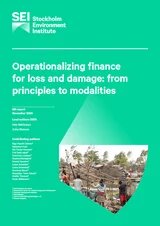Operationalizing finance for loss and damage
Vulnerable countries and communities are already facing loss and damage resulting from climate impacts, and urgently need financial support to recover and rebuild livelihoods and infrastructure. Despite increasing demands, however, finance for addressing loss and damage has been largely absent and falls far short of the scale of needs. There are also gaps in the existing climate finance architecture that make it unsuitable for addressing loss and damage.
This report draws on literature on the effectiveness of climate finance and development and humanitarian assistance to set out key principles for loss and damage finance that are grounded in climate justice. The authors find that the following principles should underpin how loss and damage finance is operationalized:
- historical responsibility and the “polluter pays” principle
- equitable and targeted support (including ensuring gender equality and protecting human rights)
- grant-based and programmatic finance
- accessibility
- recipient ownership
- transparency and accountability.
Second, the authors draw on interviews with key stakeholders to present options for how those principles can be operationalized within a potential global loss and damage finance facility, including what structures and modalities need to be put in place at the global, national and sub-national level. A key finding is that modalities for loss and damage finance should be designed to place the needs and priorities of vulnerable communities at the centre. This includes giving those communities significant autonomy and decision-making power over how finance is utilized in line with their needs. Small grants and unconditional cash transfers, as opposed to loans or project-based finance, are also likely to be more accessible for recipients and more successful in reaching affected communities.
Overall, both the literature and the interviews show that successful examples of just and effective delivery of climate finance tend to be small-scale projects that offer direct access at the community level. While many such models are still at the pilot stage, the authors suggest that they could be a practical and effective way to deliver loss and damage finance, and offer an opportunity to test innovative approaches combined with inclusive learning processes. This could also catalyse the shift of climate finance altogether towards practices better aligned with climate justice.
Product details
Table of contents
Executive summary 4
1. Charting the loss and damage finance gap 6
1.1 The need for loss and damage finance 6
1.2 Gaps in current structures financing activities to address loss and damage 8
2. Principles for fair, feasible and effective loss and damage finance 11
2.1 Historical responsibility and “polluter pays” 12
2.2 Equitable and targeted support 13
2.3 Grant-based, programmatic finance 14
2.4 Accessibility 15
2.5 Recipient ownership 16
2.6 Transparency and accountability 17
2.7 Key takeaways 18
3. Envisioning a new loss and damage finance facility 19
3.1 Learning from past and present experiences 20
3.2 Global level 23
3.3 National Level 25
3.4 Sub-national level 27
3.5 Key takeaways 28
4. Conclusion and key messages 30
4.1 Next steps 31
References 32
Annex 1. Literature reviewed associated with loss and damage finance principles 38
Annex 2. Interview questions 38
